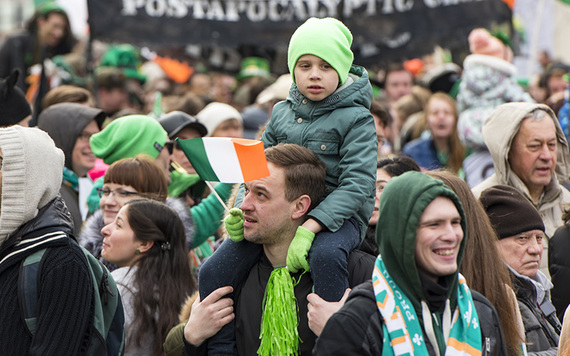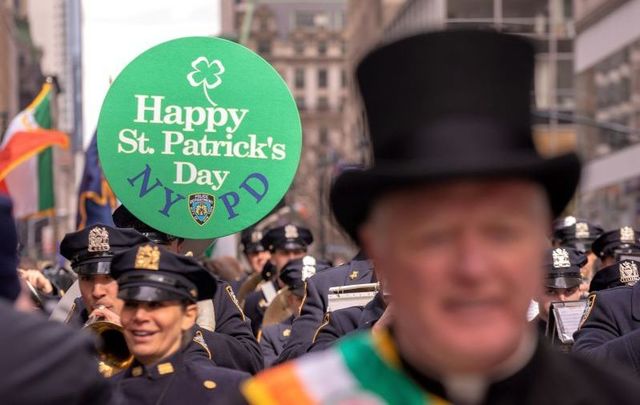Why New York's St Patrick's Day parade should always be about inclusion instead of exclusion
Writer Colin Broderick holds many fond memories of the New York City St. Patrick’s Day parade, but until gay groups could march with their own banners, he said that he would never pass the tradition of attending the parade to his daughter.
It wasn't until March 2015 that LGBTQ groups were welcome to march down Fifth Avenue alongside their countrymen and women; proud of their nationality, of their heritage, and of their sexuality.
As we draw closer to the anniversary, Broderick's 2014 essay on his experience of the parade and how it allowed him to feel included in the US story underlines just how important a move it was to allow all groups to march and how vital it was to put an end to years of inequality.
The below was written in 2014:
Twenty-five years ago I attended my very first Fifth Avenue St. Patrick’s Day parade in New York. I’d been living in the Bronx for just under a year and had heard so much talk about it that I just had to go see this grand spectacle for myself.
On the morning of March 17, a few of my construction friends and I skipped work for the day and boarded the 4 train out of Woodlawn bound for the Upper East Side of Manhattan. The train that ferried us onto the island that morning was awash in a sea of green t-shirts, comical felt top hats, girls with shamrocks painted on their rosy cheeks and bright-faced boys carrying plastic shillelaghs wearing hopeful grins and t-shirts that read, “Kiss Me I’m Irish.”
Sure, it was ridiculous. Of course, it was over the top. And yes, our behavior catered to every Irish stereotype from Malin to Mizen Head, but there was also in the air that morning a genuine sense of jubilation.

Would you bring your children along to the St Patrick's Day parade in New York? Image: iStock.
Read More: Staten Island St. Patrick's Day parade bans LGBT - the dying gasp of exclusion
We were 3,000 miles from home, many of us lonely, many of us disconnected, some missing their families, many of us looking for some small way to connect for a day. We were looking to rejoice in our Irishness, to stand side by side with our Irish and Irish American brothers and sisters in the hope of some semblance of national unity, and hoped that for a few short moments we might feel that we belonged.
Having just left my own home in Northern Ireland I was still in a state of perpetual bliss at the freedoms we Irish were granted here in America. Where I grew up in the North, there was no such thing as flying our national Irish flag on the front lawn or wearing a shamrock adorned t-shirt as you casually strolled down the streets of Omagh, Derry, or Belfast.
The freedom represented up and down Fifth Avenue on the morning of March 17 was, in essence, for me a day of national celebration of our identity, a day to be able to express fully who we were, out in the open for all to see.
But it was more than that for me. It was more personal, having spent my life feeling like I was “different.”

Fifth Avenue during the St Patrick's Day parade. Image: iStock.
Read More: Staten Island continues to ban LGBTQ group from St. Patrick’s Day parade
America basically afforded me the gift of freedom to be myself. Here in America, I could be myself, and that was going to be perfectly okay. What a profound gift to the human spirit, the freedom to be yourself. Is it any wonder we were in such a joyous mood?
Yes, I drank too much that day and on many the St. Patrick’s Day afterward, but that’s a story that belongs in a different essay. What I want to touch on here is that over the past decade I have stopped going to the St. Patrick’s Day parade on Fifth Avenue.
It no longer represents for me what it once did. I now have a five-year-old daughter who has never been to the parade.
I would love to take her. I would love to share with her some of that same sense of cultural pride and jubilation that the parade once represented for me, but I won’t, I can’t, not in good conscience.
The parade feels anti-American to me now. Worse, it feels anti-Irish.
Its exclusion of our gay brothers and sisters triggers in me some of the very same rage that I felt upon leaving Northern Ireland over a quarter of a century ago. A rage that was founded in repression of identity.
I’m not going to get into a whole big song and dance about what the legalities of the situation are regarding the parade because for me it’s a semantic argument I don’t care to indulge.

The New York St Patrick's Day parade. Image: iStock.
Read More: Newlyweds “humbled” to be Northern Ireland’s first legally married same-sex couple
Here’s what’s important about the argument – gay people, whether Irish or not, have lived with enough judgment. They have suffered enough indignity at the hands of bullies and ignoramuses the world over.
To exclude or even to make any of our fellow humans “feel” as though they are not equal in some way is morally repugnant to me, and anyone who thinks differently in this day and age should be ashamed of themselves.
To you Irish who are championing exclusion here in this great country I say, how dare you! How dare you judge!
America took you in, warts and all. It opened its arms and said, “Yeah, come on in. You look a bit sketchy, but what the hell, you’re welcome to come in.” Remember that part?
It’s time to change the old guard, to sweep out the antiquated thinking in some Irish circles in this town. It’s time to be brave enough to open your arms and hearts and welcome all Irish people to openly celebrate St. Patrick’s Day.
What exactly are you afraid of? That someone might wear pink instead of green for a change? I for one love the color pink, and, as for my daughter, it's her favorite color of all.
Read more: The New York parade does not discriminate, gays are welcome
*Originally published in 2014.
Have you ever attended the St Patrick's Day parade in New York? Did you enjoy the atmosphere? Let us know about it in the comments section, below.




Comments